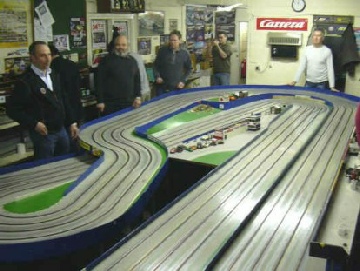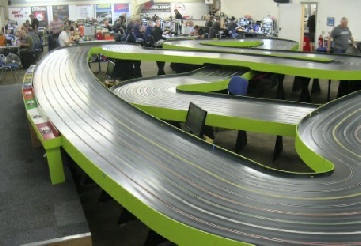
Slot Car Racing -
Organised slot car racing has come a long way since the humble beginnings using home set equipment in the sixties. Modern cars can lap a typical 30 meter club track in 5 seconds. In those 5 seconds the driver has to brake and drive round 6 or more corners. The faster cars are capable of 60 mph on the straights. (that's actual speed not scale speed) and have covered over 400 miles in 24 hours.
What size are the cars?
There sizes of car regularly raced are.
1/32 scale cars which are about 15cm long by 6.4 cm wide.
1/24 cars which are about 19cm long by 8 cm wide.
(Both 1/32 and 1/24 cars can run on the same track. )
The smaller HO cars run on a different type of track
All models have to resemble a full size racing car, racing is divided between classes for Grand Prix, Sports/GT and Saloon cars Click here for technical details of the cars.
What guides the car round the track?
There is a T shaped guide at the front of the car which fits in a slot cut in the track surface.
What sort of track is used?
Almost all clubs build their own tracks. These are usually built with the slot cut in either MDF board or chipboard. Most tracks are built on a wooden frame raising the track surface about 80 cm. from the floor. These tracks work on a similar principle to the plastic track supplied with home sets. Most British club tracks have 4 lanes, but a few clubs have 5, 6 or even 8 lanes. The lap lengths of the tracks are typically between 20 and 50 metres. Every clubs track is different, some have short straights and tight corners, others have long straights and fast sweeping corners, many have all these features. Click here for a guide to track building and maintenance.
Tracks around the country -
What powers the cars?
The track power is 12 volts d.c. Most clubs now use regulated power supplies although some use a car battery with a suitable charging system. Electric current is fed via the drivers hand controller to copper braids (or tapes) either side of the slot in the track surface The car picks up this power with braids on either side of its guide. these pick up braids are wired to an electric motor at the back of the car which drives the rear wheels.
How are the cars controlled?
Each driver has a hand held controller which contains a variable resistor or a transistorized circuit. A spring loaded plunger or trigger varies the amount of power supplied to the car.... the harder the driver presses down the faster the car goes. To slow the car, the driver releases the plunger / trigger , power is removed and a system of "dynamic braking" is applied. This "dynamic braking" is when the motor acts as a dynamo and generates its own braking force. Click here for more information on controllers.
What happens when the cars come out of the slot?
During a race marshals are stationed round the track with the job of putting the
cars back in the slot. Each lane is colour coded by means of a line painted on the
track, coloured stickers on the cars tell the marshal which lane the de-
How do we know who wins a race?
On completion of each lap every car trips an automatic electronic counter. The laps are recorded on a digital display in front of the race controller. Races are often over a fixed length of time, so the 1/00 of a lap covered in the time are recorded as well as the number of complete laps. Click here for technical details of lap counting.
What makes a good driver?
The skill is to drive as fast as possible without falling out of the slot. You have
to slow down for each corner, drive smoothly round, and then accelerate away on full
power down the next straight.. If you go too fast into a corner, or apply too much
power in a corner the car will come out of the slot. If you "de-
What are the duration of races?
Club races are usually 3 or 5 minutes long. Typical championship races have 3 minute
heats, 5 minute semi-
What makes a car fast.
The slot cars capable of such high speeds have come about through many years relentless development. The engineering bears little resemblance to the home set type cars. The motors develop a lot of power, so the fastest cars can achieve over 60 mph in under 10 meters of straight together with light weight and a low center of gravity to help the chassis cornering performance.
The bodies are feather light, as heavier bodies make the car tend to tip over on corners. The bodies are made from transparent plastic, and are painted on the inside in the colour of the drivers choice. These bodies last a lot longer than you might think, they are flexible enough to deform in a crash, and then spring back to the original shape.
The chassis, although very light have carefully developed flexible and hinged parts to achieve high cornering speeds, and perhaps more important to make them handle so the driver can drive them close to the limit consistently. Much club racing uses simple 2 part pressed steel production chassis. The higher performance cars have more sophisticated chassis with many separate parts made from spring steel, and brass. Many clubs also run races for the hard bodied home set type cars.
How do I get started?
The best way is to go along and join one of the many slot racing clubs around the country. Here you will meet many people who can help and advise you to acquire the necessary driving and chassis building skills. Click here for a full list of clubs Many clubs have their own web sites there are links to these from the Association web site.
What do I need?
To start with you will need a car and a controller. At first seek the advice of other club members. Clubs will usually have cars and controllers available to try. What cost is involved? Production cars are available from about £60.
What is the BRITISH SLOT CAR RACING ASSOCIATION (B.S.C.R.A.)
B.S.C.R.A is the controlling body for slot car racing in the UK. On this BSCRA web site there are articles on car, controller and track building, race reports, news of new products etc. See our handbook which includes the rules and a list of clubs in the UK. We organise races at regional and National level, and (in co operation with international slot car racing organisations) organise international events including the World Championships. BSCRA membership details.
Notes
HO
HO are the smallest cars normally raced, they are nominally 1/64 scale. They are
run on proprietary track which is substantially narrower than the track needed for
larger scale cars. BSCRA has close ties with HO race organizers although BSCRA
standards only cover 1/32 and /24 cars.
Regulated Power Supplies
These are power supplies where the voltage stays constant
under different loads. More basic power supplies are not regulated, and the voltage
changes depending on how much current the cars are taking.
Scale Speed
The speeds quoted on this page are real speeds. Some people talk about
scale speed. However there are several different ways of calculating scale speed,
so "scale speed" doesn't mean much unless it is made clear which type of scale speed
they are talking about. Everybody can enjoy slot racing without trying to understand
this somewhat advanced technical area, so I won't attempt to explain it here. I
recommend sticking to real speed as this is easily understood and unambiguous.
Copyright © 1977 to 2020 British Slot Car Racing Association All rights reserved
Copies of this page may be freely used to publicize slot car racing providing a acknowledgement to the British Slot Car Racing Association is included.



Typical club track
National championship track